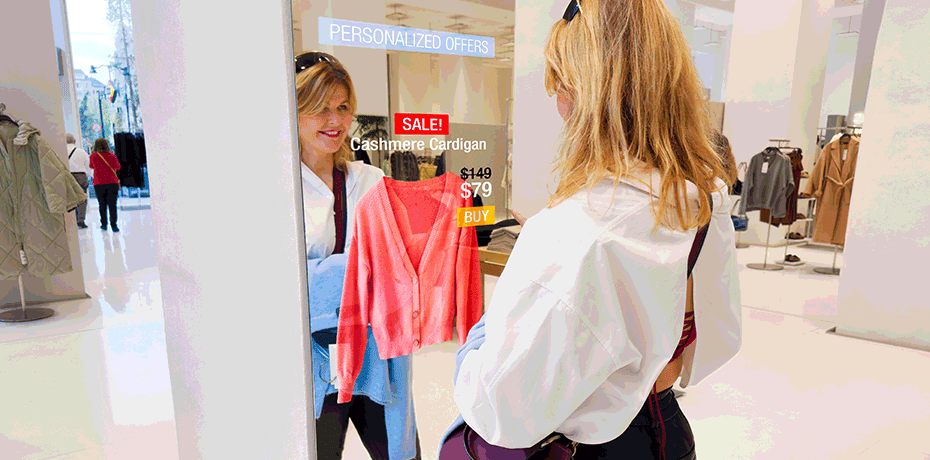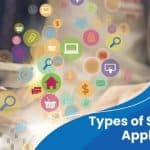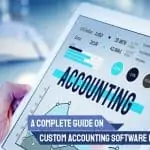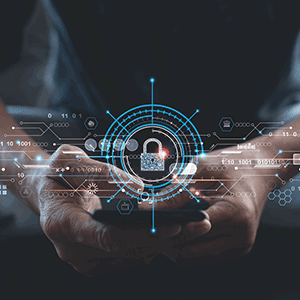Category: Technology
In the fast-paced world of business, where attention spans are shrinking and competition is fierce, a successful product launch can make all the difference.
You’ve invested countless hours refining your product, and now, armed with enthusiasm, you unleash it onto the world with a dazzling demo. But wait – the anticipated traction is not materializing as expected. Why aren’t those product demos generating the buzz they deserve?
The answer is: The Experience Factor!
A demo isn’t just a monologue; it’s an experience. Engage your audience, invite them to interact, and make them a part of the journey. Show, don’t just tell. Create an environment where they can visualize how your product will seamlessly integrate into their lives or businesses. An immersive experience can leave a lasting impression, making your demo unforgettable.
Enter Augmented Reality (AR), a groundbreaking technology that has the potential to reshape the way we approach product demonstrations in the modern era.
What is a Product Demo?
A product demo is a captivating showcase that goes beyond bullet points, offering a firsthand experience of a product’s capabilities. It’s your chance to bridge the gap between specs and reality, transforming mere potential into tangible value.
In the not-so-distant past, product demos took place in boardrooms, where physical prototypes and eloquent speeches reigned supreme. Today’s successful demos are about more than just features – they’re about engaging narratives, relatable experiences, and real-world solutions that resonate with a global audience.
Read more: 7 Ways Augmented Reality Will Transform Experiential Marketing in 2023 and Beyond!
Is AR Key to Successful Product Demos?
While AR isn’t the only ingredient in the recipe for a successful product demo, its charismatic allure undeniably transforms the way we showcase products. By harnessing AR’s capacity to blend reality with the extraordinary, you open doors to unparalleled engagement, experiential storytelling, and a sense of wonder that captivates audiences like never before.
As the lines between virtual and physical continue to blur, one thing remains certain: AR holds the key to unlocking a new era of captivating, compelling, and unforgettable product demos.
AR lets you add virtual layers to the world around you, all through the lens of a device like a smartphone or AR glasses. It’s as if your reality gains an extra dimension – a dimension where products come alive to showcase their features and capabilities.
AR Redefines Product Demos: Use Cases
With AR, your customer need not be guessing and hoping – they get to see exactly how the product fits into your world. But AR doesn’t stop there. It’s not just about seeing products in your space – it’s about interacting with them too. Let’s now consider a few use cases.
1. Interactive product demos
AR lets you do all this and more. It’s like having a futuristic playground where you can experiment with products before making a decision.
Case Study: Captivating 385 Million
Challenge: Pepsi Max aimed to share their “Live For Now” brand message through an interactive digital OOH campaign that would resonate with its audience.
Solution: The interactive product demo with AR transformed a mundane bus shelter display into a captivating window to augmented reality. Using bespoke 2D and 3D elements merged seamlessly with the live street view through depth mapping; they orchestrated scenes beyond imagination. These unbelievable moments were captured on day one and spun into a captivating social film for online sharing.
Results: The campaign’s impact was nothing short of remarkable. The YouTube views surged to an astonishing 8 million, with 3 million views achieved within a mere 5 days. The campaign sparked a global PR frenzy, engaging a massive audience of 385 million. Renowned media outlets like ITN, CNN, and BBC Click couldn’t resist the allure and featured the viral video, also spotlighting the underlying technology. Sales of Pepsi Max soared by an impressive 35% YoY during the campaign’s month. The campaign’s brilliance and ingenuity were recognized with over 20 awards, including the prestigious Bronze Outdoor Lion.
2. 360 Product demo
The prowess of a well-crafted 3D product demo not only slashes redundant explanations but also conserves precious time and resources for your team.
Empower your clientele with the ability to explore your offerings from every perspective, delve into intricate details up close, and actively engage with your product. The future of showcasing is here – make it yours.
Case study: Converting curiosity into confident purchases
Problem: Heals recognized a common challenge faced by customers – the quest for the perfect furniture piece transcending the expertise of interior designers. Its customers needed a way to envision how each piece would fit into their spaces before making a decision. This lack of visualization often posed a hurdle in the purchasing process.
Solution: Heals ingeniously integrated 360-degree spin product views into their offerings. While others offer zoom features and color options, Heals takes it a step further. They allow shoppers to envision how each piece seamlessly fits into their living rooms, bedrooms, or dens. This transformative touch helps shoppers convert their browsing curiosity into confident purchases.
Result: Furniture shopping is a natural ally in 360-degree product viewers, especially because these pieces often get shipped to customers’ homes. The tactile experience is absent in this scenario, but Heals bridges the gap. By offering this immersive experience, they empower customers to finalize their decisions and confidently click “buy now.” Heals doesn’t just sell furniture; they sell confidence and certainty in each purchase.
4. 3D AR product catalog
A 3D catalog is a digital collection of products showcased in three-dimensional space, enabling users to interactively explore and view items from different angles, providing a lifelike experience for better understanding and decision-making. It offers a dynamic alternative to traditional static catalogs, allowing customers to engage more deeply with products before purchasing.
Case study: Matching Evolving Market Demands
Problem: Cisco, a frontrunner in technology, faced the challenge of enhancing its 3D interactive catalog, developed back in 2006, to match evolving market demands.
Solution: In 2017, Cisco elevated its game by transforming its extensive inventory of 800+ 3D products into immersive 360-degree photo-realistic AR designs. These designs could be activated across multiple devices, transcending the realm of mobile phones.
Results: Cisco’s investment reaped rapid rewards. The AR catalog triggered a remarkable 9% surge in booth traffic YoY at trade shows. Attendees spent more time at the booth, fueling heightened engagement levels. Moreover, the catalog slashed product shipping costs by an impressive 65% and armed salespeople with an expanded array of accessible products. Cisco’s strategic move didn’t just address their challenge – it revolutionized their engagement and operational efficiency.
Read more: Augmented Reality In Retail Reimagining the Future Of Shopping
Utilize AR for Your Product Launch and Product Demo with Fingent!
We at Fingent top software development company know the secret recipe: we blend your product’s essence with AR magic. Imagine your audience entering a world where your product isn’t just shown but comes alive. Fingent crafts AR experiences that let customers interact, explore, and feel your product – like they’re part of a captivating story.
But it doesn’t stop at the launch – we transform product demos where customers don’t just watch a demo; they experience it. Your product becomes more than a concept; it’s a tangible adventure they can touch, see, and believe in.
Fingent’s expertise isn’t just about the technology but your success. We tailor augmented reality solutions to your brand, ensuring your message resonates with customers. We guide you through the process, making the seemingly complex delightfully doable. Fingent doesn’t just help you implement AR; we create an immersion, a connection, and a memory etched in minds.
Give us a call, and let us turn your business dreams into reality.
Stay up to date on what's new

Featured Blogs
Stay up to date on
what's new



Talk To Our Experts
Businesses find themselves at a critical juncture as customer expectations soar and their loyalty hangs by a thread. The key to captivating and retaining customers lies in mastering the art of seamless omni-channel experiences—an unparalleled approach that fuels growth, builds unbreakable bonds, and sets organizations apart in the digital era.
Embracing this transformative strategy is no longer a choice but a necessity. Thankfully, at the forefront stands SAP Customer Experience, empowering businesses to redefine the very essence of customer engagement.
In this blog, we dive into the crucial significance of delivering seamless omni-channel experiences in the digital era and explore the pivotal role played by SAP Customer Experience in achieving omni-channel excellence. We will also take a look at the success stories of industry-leading companies that benefited from SAP customer experience.
Meaning and Significance of Omni-Channel Customer Experiences
Today, customers’ journey has become complex and dynamic. It spans various touchpoints such as websites, mobile apps, social media platforms, physical stores, and more.
Omni-channel experiences refer to the seamless integration and synchronization of these channels, providing customers with a consistent and cohesive journey regardless of the device or platform they choose to engage with.
It involves delivering a unified and personalized experience that transcends individual touchpoints. To achieve success most businesses have adopted SAP customer experience. Let’s delve into it to understand how it can enhance omni-channel experience.
SAP Customer Experience – Where the Boundaries Between Channels Dissolve
SAP Customer Experience stands as a transformative force, reshaping how businesses engage with their customers across the entire journey. From capturing initial interest to post-purchase satisfaction, SAP Customer Experience covers every aspect of the customer lifecycle, enabling organizations to forge lasting relationships and foster brand loyalty.
By leveraging the power of integrated data, intelligent insights, and personalized content, SAP Customer Experience empowers organizations to deliver consistent, contextual, and captivating experiences across every touchpoint.
With SAP Customer Experience, businesses can unlock the true potential of omni-channel excellence, creating a symphony of interactions that resonate with customers on a profound level. By seamlessly connecting commerce, marketing, sales, service, and customer data, SAP Customer Experience sets the stage for organizations to thrive in the digital era, building lasting customer relationships and achieving unparalleled success.
SAP Customer Experience- Where Extraordinary Customer Experiences Take Center Stage
SAP customer experience strategies not only meet customers’ rising expectations but also provide valuable insights into their preferences and behaviors, enabling organizations to make data-driven decisions and tailor their offerings more effectively. Consider a few key elements of a successful omni-channel strategy:
- Weaving the Threads of Connection: Like the threads woven meticulously into the fabric, a successful omni-channel strategy integrates various channels, ensuring they work harmoniously to deliver a consistent and unified brand experience.
- Insights as Your North Star: By leveraging data from various channels, you gain a deep understanding of your customers’ preferences, behaviors, and needs. These insights fuel your strategy, allowing you to create highly personalized experiences that resonate with each individual.
- Personalization: Just as a perfectly tailored suit enhances confidence, personalization in the omni-channel realm enhances customer satisfaction. By tailoring content, recommendations, and promotions to individual preferences, you create meaningful connections that build loyalty and trust.
- Orchestrating Symphony of Consistency: Consistency across channels is the melodic backbone of your strategy. From the visual identity to the tone of voice, maintaining a consistent brand presence reinforces recognition and cultivates a sense of trust among customers.
- Real-Time Responsiveness: Being able to engage with customers in real-time enables you to provide immediate support, address concerns, and deliver personalized offers. This responsiveness creates a delightful experience that makes customers feel heard and valued.
- Seamlessness: Customers should effortlessly move between channels, with their journey continuing seamlessly, preserving their progress, preferences, and context.
Read more: Optimizing SAP Systems for Better Performance.
Real-World Success Stories of SAP Customer Experience Implementation
SAP Customer Experience presents compelling use cases for different industries and challenges. By leveraging the suite’s capabilities, organizations can overcome the challenges they face, be it in retail, e-commerce, or B2B sectors. From creating a unified shopping experience, and driving personalization, to streamlining sales processes and enhancing customer service, SAP Customer Experience provides the solutions needed to achieve omni-channel excellence and deliver exceptional customer experiences.
1. Retail industry: Creating a unified shopping experience across online and offline channels
Challenge: The retail industry faces the challenge of bridging the gap between online and offline channels to deliver a seamless shopping experience. Customers expect consistent product information, pricing, and promotions regardless of whether they interact with a brand online or in a physical store. Aligning inventory, customer data, and processes across these channels becomes crucial for success.
Solution: SAP Customer Experience offers a comprehensive solution for retailers to overcome this challenge. By integrating SAP Commerce Cloud with their existing systems, retailers can synchronize product catalogs, pricing, and inventory in real-time. This ensures that customers receive accurate and consistent information, whether they browse online or visit a store. Additionally, features like click-and-collect and endless aisle empower retailers to offer flexible shopping options, creating a unified experience that seamlessly blends online and offline channels.
2. E-commerce sector: Driving personalized recommendations and targeted marketing campaigns
Challenge: E-commerce businesses strive to deliver personalized experiences that resonate with customers, driving engagement and conversions. However, understanding customer preferences, delivering relevant recommendations, and executing targeted marketing campaigns at scale can be a significant challenge.
Solution: SAP Marketing Cloud, a component of SAP Customer Experience, equips e-commerce businesses with the tools to address this challenge. By leveraging customer data, machine learning, and predictive analytics, SAP Marketing Cloud enables businesses to understand individual customer preferences and behavior. This valuable insight fuels personalized product recommendations, tailored content, and targeted marketing campaigns across various channels. The result is a highly engaging and relevant experience that resonates with customers, increasing conversions and fostering brand loyalty.
3. B2B organizations: Streamlining sales processes and enhancing customer service through omni-channel support
Challenge: B2B organizations often have complex sales cycles and multiple touchpoints for customer interactions. The challenge lies in streamlining these processes and providing consistent support across channels while maintaining personalized and high-quality customer service.
Solution: SAP Sales Cloud and SAP Service Cloud, components of SAP Customer Experience, are tailored to address the unique needs of B2B organizations. SAP Sales Cloud offers comprehensive sales management tools, empowering sales teams with real-time insights, streamlined processes, and collaborative capabilities. This allows for efficient management of complex sales cycles and ensures a consistent experience for customers, regardless of the channel they engage through.
Watch now: Why Businesses Should Opt for SAP to Fuel Their Growth & Success?
Best Practices for Crafting Seamless Omni-Channel Journeys through SAP Customer Experience
Following best practices like these mentioned below will help in successfully implementing SAP Customer Experience:
- Conduct a comprehensive analysis of existing customer touchpoints: Conducting a comprehensive analysis involves examining all the channels through which customers interact with your brand, including websites, mobile apps, social media platforms, physical stores, and call centers. This will help you can identify areas of improvement and uncover opportunities for delivering a seamless omni-channel experience.
- Define clear omni-channel objectives and KPIs: Well-defined objectives and KPIs can help you can track progress, measure success, and make data-driven decisions throughout the implementation process.
- Establishing seamless integration between SAP Customer Experience modules and existing systems: By integrating SAP Customer Experience with existing systems such as CRM or ERP, you can leverage existing data and workflows, streamline operations, and maximize the value of the solution.
- Continuous monitoring and optimization of omni-channel experiences: Implementing SAP Customer Experience is not a one-time task but an ongoing journey of continuous improvement. Identifying areas for optimization can enable you to make informed decisions to refine and enhance the omni-channel experiences you deliver, ensuring they remain relevant, engaging, and effective.
How Fingent Can Help Leverage SAP Customer Experience
Partnering with Fingent can unlock the full potential of SAP Customer Experience for your business. With our expertise in SAP implementation and customization, we can guide you through the journey of leveraging emerging technologies, integrating IoT devices, and harnessing predictive analytics.
Our deep understanding of customer experience trends and innovative solutions enables us to tailor SAP Customer Experience to your specific needs, ensuring that you stay ahead of the curve in this rapidly evolving landscape.
Reach out to us, and let’s discuss your needs.
Stay up to date on what's new

Featured Blogs
Stay up to date on
what's new



Talk To Our Experts
Today, technology seamlessly weaves its way into every aspect of our daily lives. That’s precisely what digital transformation is all about – a process that enables businesses to harness the power of cutting-edge technologies and revolutionize the way they operate, engage with customers, and flourish in today’s fast-paced world.
Digital transformation goes beyond a mere trend; it’s a profound shift that can reshape the very core of a business. It allows organizations to metamorphose and emerge stronger and more adaptable than ever before.
In this blog, we’ll embark on an exciting journey to understand the significance of digital transformation, explore its key components, and learn from real-world examples of successful transformations. We will understand why it holds the key to shaping the future of businesses worldwide.
Understanding Digital Transformation
Imagine taking your cherished family recipe and giving it a modern twist with new ingredients, cooking techniques, and flavors. That’s the magic of digital transformation – a process that revitalizes businesses by infusing cutting-edge technologies into their core operations, just like the innovative twist to your traditional recipe!
Which digital technologies enable transformation?
Digital technologies, like cloud computing, Artificial Intelligence (AI), and the Internet of Things (IoT), play a vital role in the business landscape.
The cloud is like a virtual pantry that stores all your ingredients and tools, making them accessible from anywhere at any time. AI acts as your sous-chef, analyzing data, providing insights, and making your decisions more intelligent. Meanwhile, the IoT is the magic ingredient that connects everything, enabling devices to communicate and create a harmonious cooking experience.
The Digital Metamorphosis: Embracing the Ever-Evolving Adventure of Growth
Digital transformation is a thrilling quest to become the best version of what your business is capable of becoming. It’s not a one-time makeover or a sudden transformation, but a continuous journey of growth and improvement. Just like you set new goals and work towards them over time, businesses must shift their perspective from considering digital transformation as a one-time project to embracing it as an ongoing process.
This journey requires a mindset shift – instead of seeking instant results; businesses must focus on long-term gains and stay committed to the process. Digital transformation demands consistent effort and dedication, as every step contributes to overall success.
Blog : How Digital Transformation in Manufacturing Is Rewriting the Future of Production
Benefits and Outcomes of Digital Transformation
The benefits of digital transformation are many, and you will discover more of them as you implement it in your business, but here are a few of its main benefits.
- Enhanced Productivity: Digital transformation ensures mundane tasks vanish from your to-do list, leaving businesses with more time and energy to focus on what truly matters.
- Delightful Customer Experiences: Businesses become experts in customer satisfaction through personalized interactions, seamless online shopping, and responsive customer service.
- Unleashing Agility: Digital transformation enables businesses to respond swiftly to changes and opportunities. They can adapt their strategies, offerings, and operations in the blink of an eye, staying ahead of the competition.
- Unraveling Insights: Digital transformation empowers businesses to harness the power of data, uncovering valuable patterns and trends. These insights guide businesses toward smarter decisions and growth like a treasure map.
- Flourishing in the Digital Kingdom: In this captivating realm, businesses hold a golden scepter of competitive advantage. Digital transformation sets them apart from their rivals, like a crown that marks them as the industry’s leaders. They become the beacon of innovation, drawing customers to their kingdom of products and services.
- Securing the Castle: Digital transformation fortifies its defenses against cyber threats and data breaches. It’s like having a strong shield that safeguards their reputation, customer trust, and sensitive information.
- Sustaining Everlasting Success: Digital transformation is not a one-time invocation but a perpetual journey of growth and adaptation. With every step, businesses evolve and renew their charm, ensuring a legacy of prosperity.
Read more: Is Open Source the Crucial Catalyst For Digital Transformation?
Overcoming Challenges and Embracing Opportunities
A digital transformation journey can empower businesses with the tools they need to thrive in a technology-driven landscape. However, this metamorphosis comes with its own set of challenges and considerations. Let’s dive into these hurdles and discover how to overcome them while achieving your organization’s goals.
1. Organizational Culture and Mindset Shift
- Challenge: The resistance to change can be deeply embedded within an organization’s culture.
- Consideration: Cultivate a growth-oriented mindset that embraces innovation and adapts to new technologies.
- Approach: Foster a culture that rewards risk-taking and encourages open communication to build trust.
2. Change Management and Employee Buy-In
- Challenge: Employees may fear the unknown and be reluctant to embrace new processes or technologies.
- Consideration: Engage employees early on in the transformation process and communicate the vision clearly.
- Approach: Encourage two-way communication, provide training and support, and celebrate small wins to build momentum.
3. Legacy Systems and Technology Integration
- Challenge: Integrating new technologies with existing legacy systems can be complex and time-consuming.
- Consideration: Evaluate the compatibility of existing systems with the new solutions you plan to implement.
- Approach: Develop a well-thought-out integration strategy, and consider phased implementations to minimize disruption.
4. Data Privacy and Security Concerns
- Challenge: The digital era brings increased risks of data breaches and privacy violations.
- Consideration: Safeguard customer and company data to build trust and maintain regulatory compliance.
- Approach: Implement robust security measures, regularly audit systems, and ensure employee awareness of data protection practices.
5. Skills Gap and Talent Acquisition
- Challenge: Finding skilled talent with expertise in emerging technologies can be challenging.
- Consideration: Upskill current employees and promote a learning culture to bridge the skills gap.
- Approach: Collaborate with educational institutions, offer training programs, and consider hiring freelancers or partnering with external experts.
Watch now: 7 Deadly Mistakes Non-Tech Businesses Make on Tech Projects
Success Stories: Real-World Examples
As businesses brace themselves for their journey, they seek inspiration from the tales of industry leaders like Amazon and Netflix. These titans have undergone remarkable digital transformations, leveraging technology to disrupt markets and revolutionize customer experiences.
Staying Relevant like Amazon and Netflix!
- Challenge: Amazon began as an online bookstore, and Netflix was a DVD rental service. Both companies recognized the need to adapt and evolve to stay relevant in the ever-changing digital landscape.
- Solution: Amazon expanded its product range, becoming an online marketplace for various goods and services, leveraging technology to optimize customer experience and supply chain efficiency. Netflix transitioned from a DVD rental service to a digital streaming platform, investing in content creation and personalization algorithms to offer a superior streaming experience.
- Takeaway: Embrace innovation and be willing to pivot when necessary to meet evolving market demands. Continuously focus on improving customer experience to build loyalty and attract new customers. Leverage technology to streamline operations and enhance efficiency.
Unifying and Protecting Data in Healthcare like John Muir Health!
- Challenge: Healthcare companies are often concerned about data security and interoperability while implementing electronic health records (EHRs).
- Solution: Healthcare providers invested in robust cybersecurity measures and interoperable EHR systems to protect patient data and facilitate efficient communication among healthcare professionals. An example is John Muir Health, which “leverages a cutting-edge data platform to unify data while also using the cloud to improve real-time patient communication. As a result, patients can ask questions and receive information through their preferred communication channel, such as email or SMS.”
- Takeaway: Understand the unique challenges of your sector and tailor the digital transformation strategy accordingly. Collaborate with industry experts and technology partners to implement suitable solutions.
Creating Seamless Experiences in Retail like Ikea!
- Challenge: Retailers struggled to bridge the gap between physical stores and online shopping, creating a seamless omnichannel experience.
- Solution: Retailers adopted advanced analytics and inventory management systems to optimize stock levels and offer personalized recommendations to customers across various channels. Ikea, for example, tripled their online sales by prioritizing the digital side of their business!
- Takeaway: Continuously monitor and adapt to the changing needs of customers and the market.
Thriving in the Digital Age: Fingent’s Unparalleled Support for Transformation
The key to sustained business success lies in continuous innovation and adaptation. As organizations strive to remain competitive and relevant, embracing digital transformation becomes imperative. Throughout this journey, Fingent emerges as a trusted partner, offering comprehensive solutions and unparalleled expertise to empower businesses and drive growth.
Fingent’s commitment to excellence and wealth of experience in guiding organizations through successful digital transformations make us a beacon of reliability. By understanding the unique challenges of each industry and sector, we tailor our solutions to meet the specific needs of our clients. From industry giants to startups, Fingent collaborates closely with organizations of all sizes, ensuring that no one is left behind in this technological revolution.
By fostering a culture of innovation and providing the necessary support and training, Fingent top custom software development company helps employees embrace the digital shift with enthusiasm and confidence. Our meticulous planning and phased implementation approach ensure a seamless transition, minimizing disruption and maximizing efficiency.
Reach out to us, and let’s lead you to success on your digital transformation journey.
Stay up to date on what's new

Featured Blogs
Stay up to date on
what's new



Talk To Our Experts
Technology successively progresses all around us; from the simplest basic Google searches to the working of aircraft, technology has indented its value in everyday life. Biometric APIs are not a foreign idea to us, and 81% of all smartphones have biometrics enabled. Passkeys (on Apple) and Google’s new standards will enable a new class of security with protection like never before. This article will discuss the rise of this form of authentication and its benefits over traditional passwords.
Security – A Major Concern
A big chunk of our daily lives revolves around our mobile phones; sometimes, it is the key to our survival. Once technology grew and mobiles were planted in people’s hands, brands and organizations became smart and decided to adopt their services into these devices. Online banking and payment methods, personal detail locks, and private picture archives evolved. These are just a few generic examples of the important things we trust our mobile phones to hold. This being the case, is it not all the more important to ensure that this technological linchpin is protected at all costs?
Cybercriminals can hack into almost anything today – cars, security cameras, door locks, baby monitors, smart TVs, and even healthcare devices. Mobile devices can be extremely vulnerable to hostile software, viruses, data leakage, and other mobile threats without tight security measures. In such situations, one can not rely only on traditional password-based systems because they will crumble under a brute-force attack.
The Rise of Biometric Authentication
In very simple words, Biometric Authentication is essentially authentication that utilizes biometrics modalities (fingerprint, facial recognition, retina scanning, voice recognition, and more) to detect and authorize the identity of the user trying to access an electronic gadget. An individual’s biometric features are unique to only themselves, and authentication based on them is guaranteed to be effective.
Here are some advantages of biometric authentication over traditional passwords:
1. High security and assurance – Traditional passwords and security codes are generally harder to remember. The biometric system eradicates this problem by offering different modes of verification instead. Additionally, since fingerprints and iris scans cannot be forged, sensitive data will remain more protected.
2. Offers The Best ROI – The biometric authentication system is famous for its matchless ROI. It is a single device that keeps a check of every employee’s whereabouts in a large enterprise. The device is significantly better than a human resource representative who would claim a hefty salary to do the same job.
3. User Experience – Using this system is very convenient as it is built into most devices. This system is highly cost-effective and extremely fast in processing. In addition, forgetting a password is an infamous mistake of most users, but with biometrics, it’s impossible to forget them.
4. Prevents forging – Since everyone has their own set of biometrics, the forging of authorization is very slim. (Unless someone decides to pull a 007 move and trace fingerprints)
Current Adoptions and Usage
The Cisco Report of Trusted Access in 2022 stated that 81 percent of all smartphones have biometrics enabled. Mobile biometric authentication can be used in numerous industries, some of which include –
1. Mobile Banking – Banks use biometrics to authenticate transactions taking place through mobile banking. They also use biometric authentication to verify customers when they try to access their mobile banking app or bank accounts. Most popular banks now introduce the fingerprint and touch method for signing into their mobile banking app.
2. Retail Shopping – Online shoppers tend to abandon their shopping cart or any purchases when they can’t remember their passwords, but facial biometrics can resolve this problem for online shoppers by providing a simpler login experience. This can directly increase retail business. Mastercard has recently introduced its Identity Check Mobile, a mobile-based biometric authentication solution that allows customers to verify their identity by sending a selfie to the online retailer’s website.
3. Healthcare – Biometric information from fingerprints, iris scanning, and facial recognition are helping hospitals to identify patients and retrieve their past medical history. Northwell Health exemplifies this use case by using iris scanning and face recognition to identify emergency patients.
Read more: How Businesses Are Using Facial Recognition to Create An Impact!
Enabling Secure Authentication with Biometric APIs
API stands for Application Programming Interface and when used in conjunction with Biometrics, it refers to the Programming interfaces of websites and applications that are powered by biometric modules. Mentioned below are the three main types of biometric authentication:
- Fingerprint Authentication – It is the most common biometric authentication method and involves scanning a user’s fingerprint.
- Face Recognition Authentication – As the name suggests, this uses the mobile device’s front-facing camera to scan the user’s face. It is very simple to use and offers a high level of accuracy.
- Iris Scan Authentication – The user’s iris is scanned for authentication in this method. Iris scan authentication is the most secure biometric authentication method as it is extremely difficult to forge.
As Biometric Authentication provides such enhanced security, almost all mobile phone brands have adopted this feature to enhance the security they can provide, thereby building more concrete trust with their customers. For iOS-running mobiles, the availability of biometric options such as Face ID and Touch ID depends on the device. All Android 10 and newer devices have biometric authentication for face and fingerprint identification.
Three distinct areas highlight how biometric APIs will potentially replace passwords:
- Security – Since each individual has unique biometric modalities, it comes as no surprise that security in biometric APIs will be far better than traditional passwords.
- Convenience – The main reason that most people despise passwords is because they can be hard to remember. Further, remembering the login passwords for all of these can be tedious since most have multiple accounts on numerous platforms. Here the use of biometric API helps again because with these APIs the need for remembering a password does not exist.
- Future proof – Progress in AI, sensor technology, and IoT will ultimately enable seamless biometric authentication. When seen this way, biometrics stands out as catering to current and future demands, unlike traditional passwords.
Benefits Of Biometric APIs For Mobile Applications
Traditional password-based authentication presents multiple challenges, including password fatigue, poor user experience, and pressure on support and IT teams when passwords need to be reset.
Biometric APIs address these issues with the following benefits –
- Reduced password fatigue – Customers are not required to memorize all their passwords when matters lie in the hands of biometric APIs. An added advantage is the mitigation of password-related risks such as weak passwords and password reuse.
- Multi-factor authentication (MFA) – SaaS companies can now imbibe another wall of security by collaborating the power of biometrics with other methods.
- Improved customer satisfaction – it goes without doubt that all these advantages of biometric authentication will ultimately win the hearts of customers.
- Enhanced security – the concept of ‘no passwords’ renders cyber attackers helpless as they have a much harder time invading laptops and smartphones that are protected with biometric authentication.
Few Successful Implementations of Biometric Authentication
Biometric systems are great and immensely beneficial wherever identification and authentication are critical.
Let’s quickly look at the most typical use cases of biometric technologies today:
- Law enforcement and public security (criminal and suspect identification) through the work of forensic analysts.
- Military (enemy and ally identification) under the leadership of the DoD Automated Biometric Information System.
- Border, travel, and migration control (traveler, migrant, and passenger identification) in the form of electronic passports.
- Healthcare and subsidies (patient, beneficiary, and healthcare professional identification) are seen with national identity cards used in European and Middle Eastern countries.
Concerns And Considerations of Biometric Authentication
Like any developing technology, biometric authentication has its fair share of considerations. Discussed below are a few of those:
1. Privacy and Data Protection Considerations – challenges in privacy arise when one realizes that biometric APIs can use your information without warning you about it at the time of registration.
2. Ensuring Accuracy and Reliability of Biometric Authentication – these are seen when there is an evident bias in the training data and declining access due to erroneous scanning and compromise of the biometric, for instance, a cut finger.
3. Regulatory Compliance and Legal Implications – when intermingling emerging technologies with biometric APIs, unexplored legal territories are bound to emerge and transcend the domain of human health.
Future of Biometric Authentication
Biometric Authentication, from its dawn, has shown true potential for progress, and it continues to be adopted into various fields of life. A TMR study predicted that the biometrics market will efficiently boom to $136.18 billion by 2031. Listed below are some trends in biometric authentication that will paint the sky in the coming years:
- Verification of Physical Identity – Biometrics powered by AI using cameras installed on-premises.
- Use of Newer Identity Markers – Modalities such as odor recognition, heartbeat pattern recognition, DNA signature, and hand geometry are being developed.
- Identity Proofing – the use of ‘liveness’ testing to guard against identity theft. This can also be accomplished with the help of AI.
- Healthcare Applications – Biometrics will verify the patient’s entitlement to specific medical treatments and medications.
Biometric systems have the untapped potential to enhance cyber functioning with biometric authentication and identity management systems. The list of actual benefits of these APIs is miles long, and the right use of these applications can benefit the entire world. Countries across the globe are adopting Biometric Authentication and systems. Will you?
Connect with Fingent top software development company to learn more about how you can leverage technology to enhance your business operations and customer experiences.
Stay up to date on what's new

Featured Blogs
Stay up to date on
what's new



Talk To Our Experts
Artificial Intelligence (AI) evolved from a concept of science fiction to a transformative force that permeates our daily lives. From autonomous vehicles to voice assistants, AI has already made significant inroads in various sectors.
However, one area that stands to gain immensely from AI’s potential is the supply chain. As the backbone of global trade, the supply chain encompasses complex networks and intricate logistics. It is an ecosystem where efficiency, accuracy, and agility can make or break success.
With its vast array of applications, AI has the potential to streamline operations, enhance decision-making, and unlock untapped opportunities. In this journey through AI’s rising capabilities, we will delve into real-world use cases that demonstrate how AI is revolutionizing the supply chain. Furthermore, we will also explore the specific benefits that AI brings to the supply chain domain.
Role Of AI Optimizing the Supply Chain
Every business owner dreams of a supply chain that is finely tuned, seamlessly efficient, and adaptive to every twist and turn of the market. A business where warehouses run like clockwork, shipments arrive precisely on time, and customer demands are anticipated with uncanny accuracy is not a far-fetched dream; it’s a reality being shaped by the game-changing role of Artificial Intelligence (AI) in optimizing supply chain operations.
At the heart of AI’s transformative influence are three key components that work in harmony to revolutionize the supply chain landscape. Let’s uncover their captivating role in reshaping the future of supply chains.
- Machine Learning and Predictive Analytics: Machine learning and predictive analytics in the supply chain are like having a trusted, experienced mentor by your side, whispering valuable insights and guidance into your ear. Machine learning algorithms analyze vast amounts of historical data to uncover patterns, trends, and potential pitfalls.
- Natural Language Processing and Chatbots: Natural Language Processing (NLP) allows you to simply ask a question about your supply chain and receive instant, accurate answers. With a chatbot available 24/7, customers can get instant responses, while supply chain teams can focus on strategic decision-making.
- Robotics and Automation: Robots, equipped with advanced sensors and AI algorithms, can perform repetitive tasks with unmatched precision and speed. From inventory management to order fulfillment, these tireless machines streamline operations, reduce errors, and enhance efficiency.
How AI Solves Supply Chain Challenges
The world of supply chain management is like a complex maze with numerous challenges at every turn. Thankfully, AI emerges as the trusty guide, equipped with the tools to solve some of the most daunting hurdles. Here are some for your reference:
1. Demand Forecasting and Inventory Optimization: This AI-powered assistant acts as your supply chain ‘savant,’ it understands your historical consumption patterns, market trends, and even factors like seasonality or promotional events.
2. Supplier Selection and Relationship Management: Choosing the right suppliers and maintaining strong relationships is like finding the perfect dance partner. AI steps in as a knowledgeable matchmaker. By analyzing vast amounts of supplier data, performance metrics, AI algorithms can assess and rank potential suppliers based on criteria such as reliability, quality, and cost.
3. Warehouse and Inventory Management: AI acts as a vigilant warehouse manager, optimizing layout, guiding picking and packing processes, and even predicting optimal storage locations. With AI-powered systems, warehouses can maximize space utilization, minimize errors, and accelerate order fulfillment, resulting in streamlined operations and satisfied customers.
4. Transportation and Logistics Optimization: AI takes on the role of coordinator who has a bird’s-eye view of the entire transportation network, utilizing algorithms to analyze real-time data on factors like traffic, weather conditions, and delivery constraints. By optimizing routes, load planning, and vehicle assignments, AI enables efficient transportation management.
5. Quality Control and Defect Detection: Think of a diligent quality inspector who never misses a flaw in a product. AI becomes this meticulous inspector, utilizing computer vision and machine learning algorithms to analyze visual data and detect defects with remarkable accuracy.
6. Risk Management and Supply Chain Resilience: AI plays this vital role just like a risk management expert. It analyzes a wide range of data sources to identify potential risks and vulnerabilities, ensuring supply chain resilience in the face of uncertainties.
7. Customer Service and Satisfaction Enhancement: AI takes on the role of a customer service representative who can swiftly address customer inquiries, provide accurate information, and resolve issues with ease. AI-powered customer service tools offer instant responses, personalized recommendations, and seamless assistance, enhancing customer satisfaction and loyalty.
Watch: Artificial Intelligence – how to navigate AI if you are not a tech company.
Remarkable Real-world examples of AI in the Supply Chain
AI transforms supply chain management like never before. Don’t take our word for it. See it in action as implemented by big players in the industry:
Use Case 1: Precision Prediction by Amazon
Problem: Traditional demand forecasting and inventory management methods often struggle to predict customer demands and optimize inventory levels in real-time accurately.
Solution: To address this challenge, Amazon has harnessed the power of AI algorithms to revolutionize demand forecasting and inventory management. By analyzing vast amounts of customer data, historical sales patterns, and even external factors like weather forecasts, AI algorithms can accurately predict demand with remarkable precision.
This AI-driven approach allows Amazon to optimize inventory levels, ensuring that popular products are readily available while minimizing excess inventory and reducing the risk of stockouts. By aligning supply with demand, Amazon is able to enhance customer satisfaction and maintain a competitive edge in the dynamic e-commerce landscape.
Use Case 2: Substitution Solution by Walmart
Problem: In online grocery shopping, customers often encounter situations where certain items they ordered are out of stock. This can lead to dissatisfaction and inconvenience, as customers may have to manually search for suitable substitutes or go without the desired product.
Solution: To address this issue, Walmart has implemented an AI-driven product substitution system. Using advanced algorithms, the system analyzes product attributes, customer preferences, and available inventory data to suggest suitable substitutions for out-of-stock items.
When an ordered item is unavailable, the AI system automatically identifies the best possible substitute based on factors such as brand, size, price, and customer feedback. It takes into account the customer’s past purchase history and preferences to make personalized recommendations. The system provides clear and transparent information to customers, ensuring they are aware of the substitution and have the option to accept or reject it.
Use Case 3: Real-Time Routing by UPS
Problem: Traditional route planning methods often struggle to optimize delivery routes efficiently, resulting in inefficient use of time, resources, and fuel.
Solution: UPS leverages AI algorithms for route optimization, enabling them to analyze real-time data on factors such as traffic patterns, delivery constraints, and even weather conditions. By considering these variables, UPS can generate optimal delivery routes that minimize distances, reduce fuel consumption, and optimize delivery time.
Through the implementation of AI in its logistics operations, UPS achieves significant cost savings, improves delivery efficiency, and reduces its carbon footprint. This AI-driven approach allows UPS to stay ahead of the competition and provide exceptional service to its customers.
Use Case 4: Valuable Vending by Coco-Cola
Problem: Traditional vending machines often lack the ability to gather real-time data on customer behavior and gauge the effectiveness of different brands and product offerings.
Solution: To overcome these limitations, Coca-Cola has implemented AI-enabled next-gen vending machines. These machines are equipped with advanced sensors, cameras, and AI algorithms that gather real-time data on customer behavior, purchasing patterns, and brand preferences.
With this newfound understanding, Coca-Cola can optimize product placements, tailor offerings to specific locations, and develop targeted marketing campaigns. Furthermore, the AI-enabled vending machines also allow Coca-Cola to remotely monitor inventory levels, predict demand patterns, and optimize restocking schedules. This ensures that the vending machines are always well-stocked with popular products, reducing the likelihood of stockouts and maximizing sales opportunities.
Use Case 5: Wonder Warehouses by Alibaba
Problem: Traditional warehouse management practices often face challenges related to inefficient storage utilization, suboptimal picking processes, and delays in order fulfillment.
Solution: Alibaba has embraced AI technology to develop smart warehouses that leverage automation, robotics, and AI algorithms. These AI-enabled warehouses optimize storage utilization, streamline picking and packing processes, and enable efficient order fulfillment.
Through the integration of AI, Alibaba achieves faster and more accurate inventory management, enhances warehouse operations, and improves overall efficiency in its supply chain. This innovative use of AI allows Alibaba to meet the demands of the e-commerce market and deliver exceptional service to its customers.
Checkout out our Infographic: Successful Logistics and Warehouse Management Practices.
Solid Supply Chain Solution with AI by Fingent
Advancements in AI technologies continue to shape the supply chain landscape, with machine learning algorithms becoming more sophisticated, natural language processing capabilities evolving, and robotics and automation becoming increasingly intelligent and adaptable. These advancements enable businesses to make data-driven decisions, automate repetitive tasks, and optimize operations like never before.
At Fingent, we understand the immense potential of AI in supply chain management and are committed to helping businesses harness its power. Our expertise lies in developing innovative AI solutions tailored to specific industry needs, integrating AI with emerging technologies, and driving digital transformation in the supply chain.
Whether it’s building intelligent forecasting models, implementing AI-powered automation, or leveraging AI-driven analytics, Fingent is dedicated to empowering organizations to thrive in the AI-driven supply chain landscape.
Businesses that embrace its potential will gain a significant competitive advantage. By leveraging AI technologies, integrating with emerging technologies, and partnering with experienced custom software solution providers like Fingent, organizations can unlock new frontiers of efficiency, innovation, and success in the dynamic world of supply chain management.
Reach out to us to get the best supply solution for your business.
Stay up to date on what's new

Featured Blogs
Stay up to date on
what's new



Talk To Our Experts
The implementation and development of immersive digital technologies such as Artificial Intelligence, Augmented Reality, Virtual Reality, Machine Learning, and 3D Configurators have drastically changed the way the world works. These technologies have proven their importance in innumerable fields and applications such as the communication and IT Service industry, Real Estate Industry, Manufacturing Industry, and many more.
In this article, we will discuss about three of these world-changing technologies and their application in the field of real estate, so buckle up and let’s get started!
AR In Real Estate
When you own a real estate business you already know that it is an ever-changing business. One day its ways of marketing are traditional and the next to take a 180 degrees turn to a completely modern approach. In this fast-paced industry, the use of Augmented Reality tilts more odds in your favor. Before we move any further let us first reiterate the meaning of Augmented Reality.
Augmented Reality (AR) is the real-time integration of digital information with the user’s environment in the form of text, graphics, audio, and other virtual enhancements integrated with real-world objects.
Although the conventional way to purchase property may be exciting, it can also be extremely tedious and time-consuming. The implementation of Augmented Reality has made this daunting process easier and less time-consuming. AR has successfully instigated realtors, builders, and real estate agents to take the leap of faith toward the digital front. With the help of this technology, they can offer better customer experience, faster purchase process, exciting tours, and boost their overall conversion rate.
Through AR clients can explore several properties and tour these properties virtually with just a few clicks in the comfort of their homes. This magical AR teleportation significantly saves valuable resources of time, energy, and money. If none of these are reasons enough, it also makes the entire process more exciting and fun.
Read more: Augmented Reality, Virtual Reality, and Mixed Reality detailed with Real-Life Examples!
Top Benefits Of Augmented Reality In Real Estate
1. Time-Saving
Augmented reality real estate applications show customers information about the building infrastructure, their effective energy rating, panes of glass used, materials used for construction, and even information about the vicinity of schools, hospitals, and community centers around the property. Although the initial installation of AR applications for real estate may cost a lot, in the bigger picture, it saves you money. MagicPlan is one such app that focuses on generating floor plans from photos helping buyers and tenants get a better sense of how to use the space and meet their needs without wasting much time and money on multiple site visits.
2. Visualization
Details about building construction can be boring to have to screen through but when you add the element of augmented reality, clients get to emerge themselves into the dimension of the property. This keeps them engaged and interested. Augmented reality applications let the customer view the property from different angles not just the bits that are captured from a camera. Vera is an apt example. The application can transform buildings into digitally reconstructed buildings from the inside out through highly accurate three-dimensional visualizations
3. Enhance Customer Experience
With all the above-mentioned benefits, customer experience is already bound to be boosted due to AR. Virtual staging enables customers to customize the interior décor and view finished goods and furniture before putting them in place. The entire experience is guaranteed to boost the client’s level of satisfaction. RealAR, an app transforming 2D floor plans and 3D models into full-blown life-size walkthroughs, gained maximum fame during the pandemic, enabling time-saving and cost-effective floor planning.
VR In Real Estate
Just like AR even Virtual Reality has set its claws deep into the real estate industry. These two technologies generally go hand-in-hand making them a dynamic power couple.
Virtual Reality is a computer-generated simulation of any 3D image or environment that is made to be interactive in a seemingly real or physical way by an individual using special electronic equipment, such as a VR helmet.
VR meets real estate at the intersection called 3D walkthroughs. These walkthroughs are a brilliantly immersive experience that enables customers to interact with the virtual environment and tour the property as if they were actually on the plot. It is no doubt that VR real estate is the next big thing in this industry and almost every VR app development company offers a specific spectrum of services in the virtual reality that cater to real estate segments. VR walkthroughs became famous during the COVID pandemic and have continued to thrive ever since.
Benefits Of VR In Real Estate
1. Immersive Property Showing
After visualizing the property most customers want to interact with it and try to cop a feel of the surrounding, VR comes in handy here. VR’s biggest strength is seen here with its ability to showcase property with a realistic and immersive experience, giving the client a chance to thoroughly explore the property. This sense of realism, familiar physics, and interactive nature unite together to create a truly immersive property showing. Virtual 360-degree walkthrough tours of the interior and exterior of the house without visiting the property in person is one major example of VR utilized for property visits.
2. Virtual Staging And Interior Design
Virtual staging is essentially being able to adjust the elements in your surrounding and furnish rooms however they like while viewing the property through virtual reality. By letting the customer customize the interior décor and design of the property, VR creates a more enhanced customer experience. VR developers can create enticing features like allowing the user to change the materials in space, try different furniture settings, modify the floor plans, or check the view from innumerable angles.
3. Collaborative Virtual Meetings And Presentations
Collaborative Virtual meetings are a method of communication that is technologically mediated and can facilitate engagement in remote and hybrid places. This simply means that customers from all over the world can view the property and interact with the real estate agency to make a purchase through these meetings and presentations. With the assistance of VR, you don’t even have to be in the same country in order to browse for property there.
Here’s an example of how Virtual Reality has eased campus visits for students, especially for those geographically challenged to explore the various educational options offered by universities.
3D Configuration In Real Estate
Real estate prices across the world are skyrocketing, and people can’t afford to spend extra money on renovations after a building is raised. If purchasing the right property is challenging, constructing a building that meets all your needs is a bigger headache, but with the help of 3D Collaborative tools, this process becomes seamlessly easy.
3D visualization tools can assist users in designing digital buildings while displaying and configuring them in real time with photorealistic detail.
Benefits of 3D Configurations In Real Estate
1. Customization And Personalization Of Properties
3D Configurators help clients personalize their environment to meet their specific needs and keep the agency more customer-centric. It allows customers to select from a range of customizable options such as flooring, furniture, colors, lighting, and exterior views. 3D configurations are essentially a way to let customers personalize property to their specifications. Enabling 3D views of construction sites and updated reports even before construction starts saves time and money.
2. Real-time Pricing And Cost Estimates
Detailed 3D configuring can make justifying prices, placing quotes, and ultimately selling property much easier. The 3D configuration also provides clients with a detailed view of a property, enabling them to understand the features and aspects that drive its true value. It gives an overall understanding of special features such as underground parking, nearby schools, fancy landscapes, and more.
3. Designing And Visualizing Floor Plans
When you use 3D Configurators your project can be displayed in astonishing detail at any stage of construction. Customers can learn and see everything involved in the project and even take virtual tours around the property. They can visualize the floor plans, project specifications, materials, and much more. 3D visualization allows users to witness photorealistic imagery and enhance the elegance of the property on sale, including its interior and exterior views. Enabling 3D visualization models of real-estate designs helps get a clear idea of what the comp[leted project will look like.
Read more: Leveraging 3D Configurators for Customer Engagement
Integration And Synergy Of AR, VR, And 3D Configuration
Integration is the combination of various elements to form an efficient system and synergy is formed when multiple systems work together towards a shared goal. When it comes to the above-discussed technologies, the synergy they form together is powerful and has left a strong indentation on the real estate industry.
1. Combined Applications And Benefits Of AR, VR, And 3D Configuration:
There are innumerable benefits of AR, VR, and 3D configurations in the real estate industry, such as – familiarity with the property, objective evaluation of the plot, high level of attention to detail, widening global opportunities, and a great marketing tool.
2. Enhanced Customer Experience And Engagement Through Integration:
As seen above, all three of these technologies have several strengths on their own, and when integrated, they form a mighty force. This powerful experience is the path to great customer experience and interactions, ultimately leading to increased profits.
3. Common Challenges Faced In Implementing AR, VR, And 3D Configuration For Real Estate Businesses:
Just as any new development would, even this integrated solution has its fair share of challenges: Cost of implementation, tossing agents out of employment, and the need to educate employees about the management of new technologies.
How Fingent Can Help
Today’s tech-savvy customers demand prompt responses, service efficiency, and enhanced experiences. To match up with the rising customer demands, Real Estate companies have no option but to adopt modern technology. AR, VR, and 3D Web Configurators are a few modern technologies enabling the Real Estate industry to create new paths of success opportunities. Fingent’s expertise in the domain has enabled many companies in real estate to innovate for better operations. Our experts use the latest technology to develop custom software solutions that cater specifically to unique property management challenges. Connect with our experts today to learn more about how we can help transform your property management business with custom-built technology solutions.
Stay up to date on what's new

Featured Blogs
Stay up to date on
what's new



Talk To Our Experts
SAP S/4HANA is a catalyst for business success, weaving its transformative power across the ERP landscape. SAP S/4HANA is more than just any software; it’s a realm of possibilities. It is like a digital fortress that integrates and orchestrates your supply chain, ensuring harmony and efficiency throughout your organization.
With a single source of truth, it empowers organizations to make informed decisions based on accurate, up-to-the-minute insights. It’s like having a trusted compass that illuminates the hidden paths of your operations, empowering you to confidently navigate the ever-changing terrain of the business landscape.
Understanding SAP S/4HANA – A Visionary Leap Into The Future
SAP S/4HANA is not your ordinary ERP solution. It harnesses the power of in-memory computing, real-time analytics, and a simplified data model to deliver a seamless and intelligent ERP experience. It is a technological marvel that blends speed, agility, and simplicity into a single transformative platform.
The shift from traditional SAP ERP systems to SAP S/4HANA marks a significant milestone in the ERP landscape. It represents a move from a row-based data model to an in-memory, columnar-based data model, resulting in lightning-fast data processing and real-time analytics.
With the transition to SAP S/4HANA, businesses unlock a plethora of benefits. They gain real-time insights for faster decision-making, simplified processes for improved efficiency, and intelligent technologies for enhanced automation and predictive capabilities. It’s like upgrading to a futuristic command center that propels your business into a new realm of success.
Let’s begin by unveiling the key features and capabilities that make SAP S/4HANA shine.
- It brings the power of real-time insights, allowing businesses to make decisions based on up-to-the-minute data.
- SAP S/4HANA simplifies processes, reduces data redundancies, and eliminates complexities to streamline operations.
- It leverages advanced technologies such as artificial intelligence (AI), machine learning, and predictive analytics to unlock automation, insights, and predictive capabilities.
Read more: A Beginner’s Guide To Implementing SAP S/4HANA
Key Benefits of SAP S/4HANA
1. Grasp The Pulse of Your Business at Any Given Moment with Real-Time Analytics.
With its in-memory computing capabilities, SAP S/4HANA processes massive amounts of data in real-time, allowing for faster and more responsive operations. With real-time analytics, you have the power to respond swiftly to changing market dynamics, identify emerging trends, and seize opportunities before they fade away. It’s like having a nimble and swift chariot that propels your business forward, helping you stay ahead of the competition.
2. Enthralling User Experience
SAP S/4HANA’s intuitive interface and personalized dashboards transform ERP navigation into a delightful journey. It’s like stepping into a realm of effortless elegance, where tasks are completed with grace and efficiency, where your teams can work seamlessly, unlocking their full potential and driving productivity to new heights.
3. Declutter Your Landscape with a Simplified Data Model
SAP S/4HANA can help you bid farewell to the tangled webs of complexity and data redundancies. It enables you to declutter your business landscape, allowing you to focus on what truly matters—innovation and growth. With a simplified data model, your organization gains agility, flexibility, and the ability to adapt swiftly to changing business needs.
Now that you are aware of the business benefits let’s discuss how you can prepare for SAP S/4HANA implementation.
Prepare For SAP S/4HANA Implementation
With the right foundations in place, organizations can embark on their SAP S/4HANA implementation with confidence, ready to unlock the full potential of this transformative platform.
1. Assessing Business Readiness:
Assessing the organization’s readiness for SAP S/4HANA implementation is like taking stock of your supplies before embarking on a grand expedition. Evaluating data readiness ensures that your information is accurate, complete, and compatible with the new system. Additionally, allocating resources appropriately – including skilled personnel and budget – ensures that you have the necessary support to navigate the implementation journey smoothly.
2. Building the Implementation Team:
On a voyage, each member has a vital role to play. Project managers steer the entire implementation process. Functional consultants bring their expertise in specific business areas, ensuring that SAP S/4HANA meets your unique requirements. Technical experts handle system configurations, integrations, and customizations. Together, this cross-functional team brings together diverse perspectives, fostering synergy and ensuring that all aspects of the implementation are addressed comprehensively.
3. Chart your Course by Defining Implementation Goals and Scope:
Defining clear goals and scope for the SAP S/4HANA implementation provides a clear direction and prevents aimless wandering. By identifying key business processes, you prioritize areas that will benefit most from the new system. This focused approach optimizes time and resources enabling effective project planning and increasing the likelihood of a successful SAP S/4HANA implementation.
Six Phases of SAP S/4HANA Implementation
Each of the following well-defined phases of the SAP S/4HANA phase brings your organization closer to harnessing its and unlocking new levels of efficiency, agility, and competitive advantage:
Phase #1 Project Planning and Preparation:
Planning and preparation are like laying the foundation for a solid structure. Activities in this phase include creating a detailed project plan, establishing timelines, and defining deliverables. By clearly outlining project objectives, tasks, and responsibilities, organizations ensure a structured and well-organized implementation process.
Effective stakeholder communication is vital during this phase, keeping everyone informed and engaged. Change management strategies are implemented to address any resistance to change, ensuring the smooth adoption of SAP S/4HANA.
Phase #2 System Installation and Configuration:
System installation and configuration start with assessing hardware requirements and designing the system landscape, ensuring optimal performance and scalability. The SAP S/4HANA system is then installed, configured, and integrated with other systems, creating a cohesive IT ecosystem. This phase requires careful consideration of factors like network infrastructure, security, and software installation.
Phase #3 Data Migration and Conversion:
Data migration and conversion are like transferring belongings to a new home. Legacy data is extracted, transformed, and loaded into the SAP S/4HANA system. This process involves data cleansing, eliminating duplicates, and ensuring data accuracy. Data validation is crucial to verify the integrity and consistency of migrated data.
Phase #4 Customization and Configuration:
This phase is like arranging furniture in a new space. Configuration involves setting up master data, defining workflows, and configuring system functionalities. This phase ensures that SAP S/4HANA aligns with the organization’s unique processes, enabling efficient operations and improved user experience.
Phase #5 Testing and Training:
Testing and training form the backbone of a successful SAP S/4HANA implementation. Thorough testing is conducted to validate the system’s functionality, performance, and data accuracy. This includes unit testing, integration testing, and user acceptance testing.
Training programs are designed to equip end-users with the necessary skills and knowledge to effectively utilize SAP S/4HANA.
Phase #6 Go-Live and Post-Implementation Support:
Going-live is like opening the doors to a new facility, enabling users to work with real data. Post-implementation activities include monitoring system performance, addressing user feedback, and providing ongoing support. Continuous improvement initiatives and enhancements are implemented based on user experience and evolving business needs. Regular system maintenance and updates ensure the system’s optimal performance and long-term success.
These are some best practices and lessons learned from previous SAP S/4HANA implementations. They offer valuable insights that can guide your organization toward successful implementation. These can help you avoid common pitfalls and maximize the benefits of SAP S/4HANA.
Read more: A Simple Guide To Handling Common SAP Errors and Troubleshoots
Strategies You Can Use to Overcome Common Challenges
Challenges during SAP S/4HANA implementations can vary, but some common ones include data migration complexities, resistance to change, resource constraints, and technical integration issues. To overcome these challenges, organizations should:
- Engage experienced consultants and leverage their expertise.
- Invest in data cleansing and migration tools to streamline the process.
- Prioritize change management activities and communicate the benefits of SAP S/4HANA.
- Allocate sufficient resources and budget for implementation and post-implementation support.
- Collaborate closely with SAP experts and leverage their guidance and best practices.
- Monitor the implementation progress regularly and adapt the plan as needed.
How Can Fingent Help?
Fingent can provide comprehensive services to deploy SAP S/4HANA for better supply chain management. We at Fingent offer consulting services to assess your supply chain management requirements and design a customized SAP S/4HANA implementation strategy. Our advisory services provide expert guidance on how to optimize your operations and drive digital transformation.
Are you currently using an older version of SAP ERP? If so, we can analyze your existing system, assess the impact of the conversion, and guide you through the conversion process.
Fingent leverages SAP Leonardo’s intelligent technologies, such as machine learning, IoT, and analytics, to enhance your supply chain management processes. With our expertise in SAP S/4HANA and supply chain management, we can guide you through the entire deployment process, from strategy and implementation to ongoing support.
Reach out to us, and let’s work magic for you.
Stay up to date on what's new

Featured Blogs
Stay up to date on
what's new



Talk To Our Experts
Stay up to date on what's new

Featured Blogs
Stay up to date on
what's new



Talk To Our Experts
Stay up to date on what's new

Featured Blogs
Stay up to date on
what's new



Talk To Our Experts
Stay up to date on what's new

Featured Blogs
Stay up to date on
what's new















































































